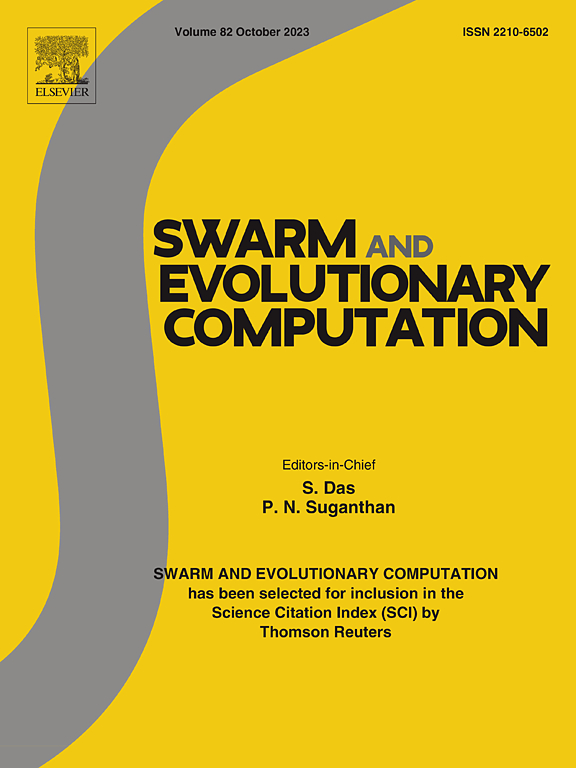Multi-attention-powered learning genetic algorithm for real-world 3D wind farm layout optimization
IF 8.5
1区 计算机科学
Q1 COMPUTER SCIENCE, ARTIFICIAL INTELLIGENCE
引用次数: 0
Abstract
Wind farm layout optimization plays a crucial role in improving wind energy utilization, reducing construction and operational costs, enhancing the reliability and stability of wind farms, and promoting technological innovation in wind energy. However, this NP-hard problem is often approached in current research under idealized conditions, typically assuming a flat plane with no consideration of elevation. To address these limitations, we propose a 3D wind farm optimization layout framework that incorporates a 3D Gaussian wake model, accounting for spatial factors like terrain elevation to more closely reflect real-world engineering conditions. To handle the high-dimensional complexity of 3D wind farm layout optimization, we introduce a multi-head attention-based genetic learning algorithm, named ALGA, that learns and leverages successful evolutionary patterns within the population. This enables the calculation of attention scores for promising regions in the search space. By iteratively refining high-scoring regions, the population achieves greater vitality and has a stronger ability to escape local optima, optimizing continuously toward the best solutions while maximizing energy conversion efficiency and minimizing wake effects. Our study involves two cases: one with ideal terrain and four standard wind speeds, and another that simulates the real terrain and annual wind conditions of the Guishan wind farm project. Across total 24 experimental scenarios, ALGA achieves the highest energy conversion efficiency, outperforming seven other state-of-the-art algorithms.
多注意力驱动学习遗传算法用于现实世界三维风电场布局优化
优化风电场布局对提高风能利用率、降低建设和运营成本、增强风电场可靠性和稳定性、促进风能技术创新具有至关重要的作用。然而,在目前的研究中,这个NP-hard问题通常是在理想化的条件下处理的,通常假设一个平坦的平面,不考虑海拔。为了解决这些限制,我们提出了一个3D风电场优化布局框架,该框架结合了3D高斯尾流模型,考虑了地形高程等空间因素,以更紧密地反映现实世界的工程条件。为了处理三维风电场布局优化的高维复杂性,我们引入了一种名为ALGA的基于多头注意力的遗传学习算法,该算法学习并利用种群内成功的进化模式。这使得计算搜索空间中有希望的区域的注意力得分成为可能。通过迭代细化高分区域,种群获得了更大的活力和更强的逃避局部最优的能力,在能量转换效率最大化和尾迹效应最小化的同时,不断向最优解优化。我们的研究分为两种情况,一种是理想地形和四种标准风速,另一种是模拟桂山风电场项目的真实地形和年风条件。在总共24个实验场景中,ALGA实现了最高的能量转换效率,优于其他7种最先进的算法。
本文章由计算机程序翻译,如有差异,请以英文原文为准。
求助全文
约1分钟内获得全文
求助全文
来源期刊

Swarm and Evolutionary Computation
COMPUTER SCIENCE, ARTIFICIAL INTELLIGENCEC-COMPUTER SCIENCE, THEORY & METHODS
CiteScore
16.00
自引率
12.00%
发文量
169
期刊介绍:
Swarm and Evolutionary Computation is a pioneering peer-reviewed journal focused on the latest research and advancements in nature-inspired intelligent computation using swarm and evolutionary algorithms. It covers theoretical, experimental, and practical aspects of these paradigms and their hybrids, promoting interdisciplinary research. The journal prioritizes the publication of high-quality, original articles that push the boundaries of evolutionary computation and swarm intelligence. Additionally, it welcomes survey papers on current topics and novel applications. Topics of interest include but are not limited to: Genetic Algorithms, and Genetic Programming, Evolution Strategies, and Evolutionary Programming, Differential Evolution, Artificial Immune Systems, Particle Swarms, Ant Colony, Bacterial Foraging, Artificial Bees, Fireflies Algorithm, Harmony Search, Artificial Life, Digital Organisms, Estimation of Distribution Algorithms, Stochastic Diffusion Search, Quantum Computing, Nano Computing, Membrane Computing, Human-centric Computing, Hybridization of Algorithms, Memetic Computing, Autonomic Computing, Self-organizing systems, Combinatorial, Discrete, Binary, Constrained, Multi-objective, Multi-modal, Dynamic, and Large-scale Optimization.
 求助内容:
求助内容: 应助结果提醒方式:
应助结果提醒方式:


